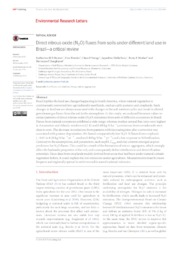Direct nitrous oxide (N2O) fluxes from soils under different land use in Brazil: a critical review.
Direct nitrous oxide (N2O) fluxes from soils under different land use in Brazil: a critical review.
Author(s): MEURER, K. H. E.; FRANKO, U.; STANGE, C. F.; DALLA ROSA, J.; MADARI, B. E.; JUNGKUNST, H. F.
Summary: Brazil typifies the land use changes happening in South America, where natural vegetation is continuously converted into agriculturally used lands, such as cattle pastures and croplands. Such changes in land use are always associated with changes in the soil nutrient cycles and result in altered greenhouse gas fluxes from the soil to the atmosphere. In this study, we analyzed literature values to extract patterns of direct nitrous oxide (N2O) emissions from soils of different ecosystems in Brazil. Fluxes from natural ecosystems exhibited a wide range: whereas median annual flux rates were highest in Amazonian and Atlantic rainforests (2.42 and 0.88 kg N ha-1), emissions from cerrado soils were close to zero. The decrease in emissions from pastures with increasing time after conversion was associated with pasture degradation. We found comparatively low N2O-N fluxes from croplands (-0.07 to 4.26 kg N ha-1 yr-1 , median 0.80 kg N ha-1 yr-1) and a low response to N fertilization. Contrary to the assumptions, soil parameters, such as pH, Corg, and clay content emerged as poor predictors for N2O fluxes. This could be a result of the formation of micro-aggregates, which strongly affect the hydraulic properties of the soil, and consequently define nitrification and denitrification potentials. Since data from croplands mainly derived from areas that had been under natural cerrado vegetation before, it could explain the low emissions under agriculture. Measurements must be more frequent and regionally spread in order to enable sound national estimates.
Publication year: 2016
Types of publication: Journal article
Unit: Embrapa Rice & Beans
Keywords: Land use change, Micro-aggregation, N2Ofluxes, Soil, Solo
Observation
Some of Embrapa's publications are published as ePub files. To read them, use or download one of the following free software options to your computer or mobile device. Android: Google Play Books; IOS: iBooks; Windows and Linux: Calibre.
Access other publications
Access the Agricultural Research Database (BDPA) to consult Embrapa's full library collection and records.
Visit Embrapa Bookstore to purchase books and other publications sold by Embrapa.

